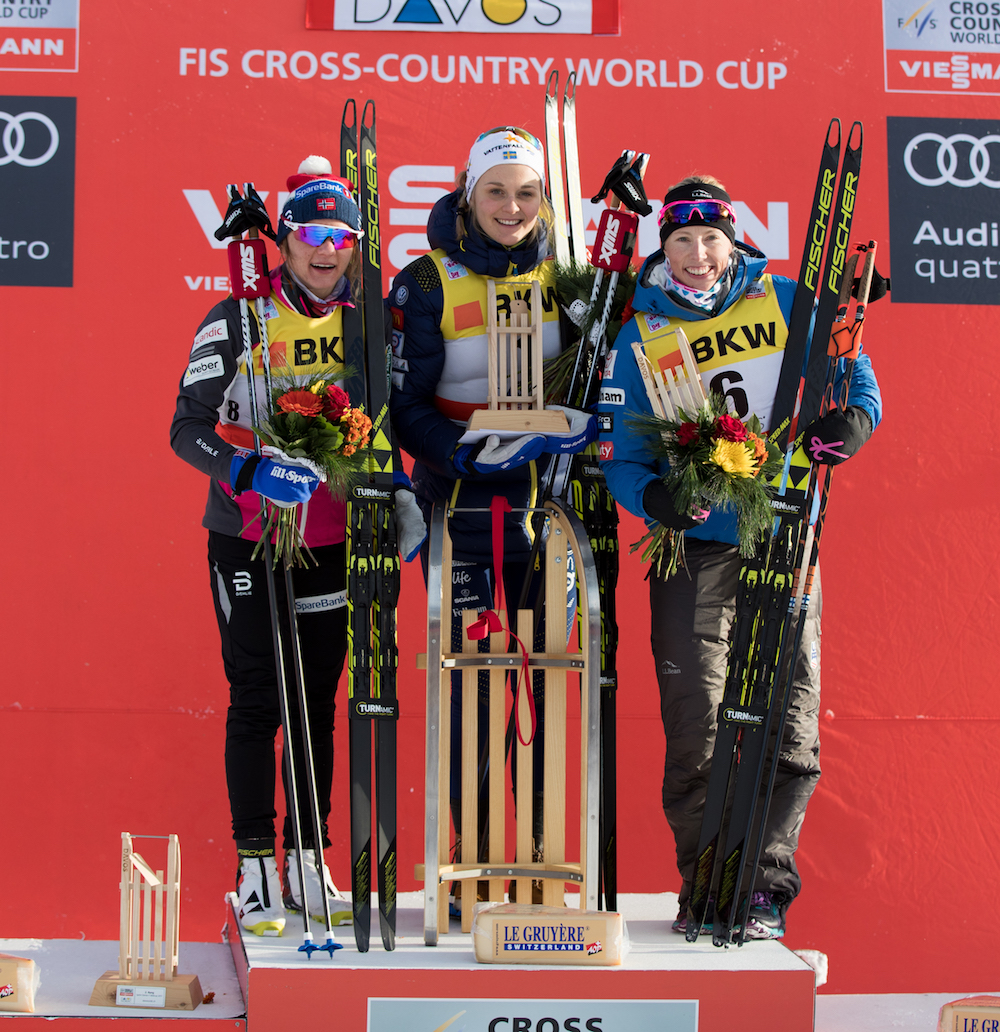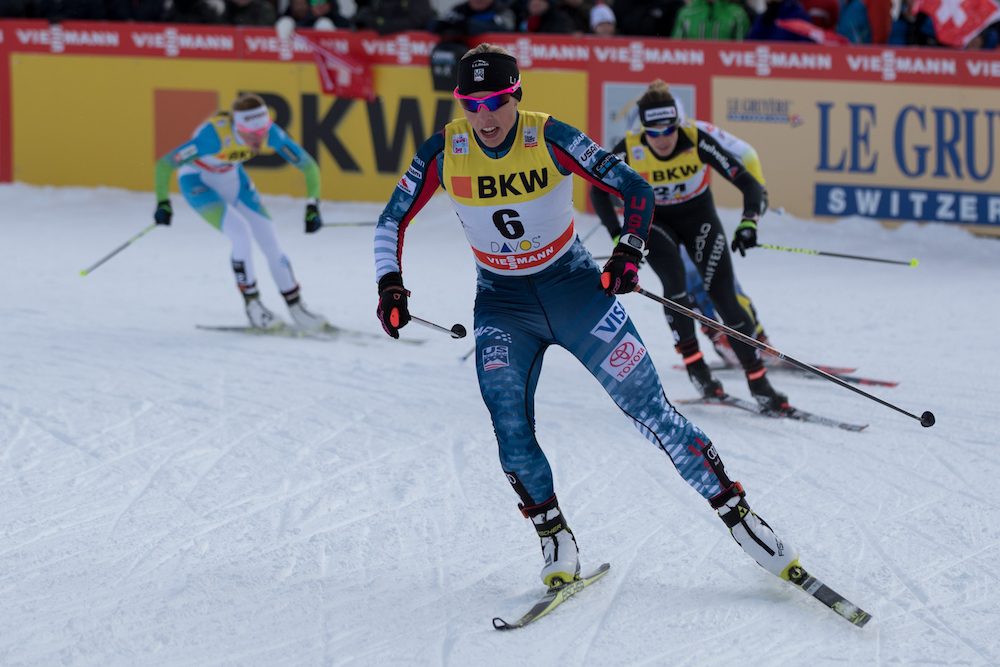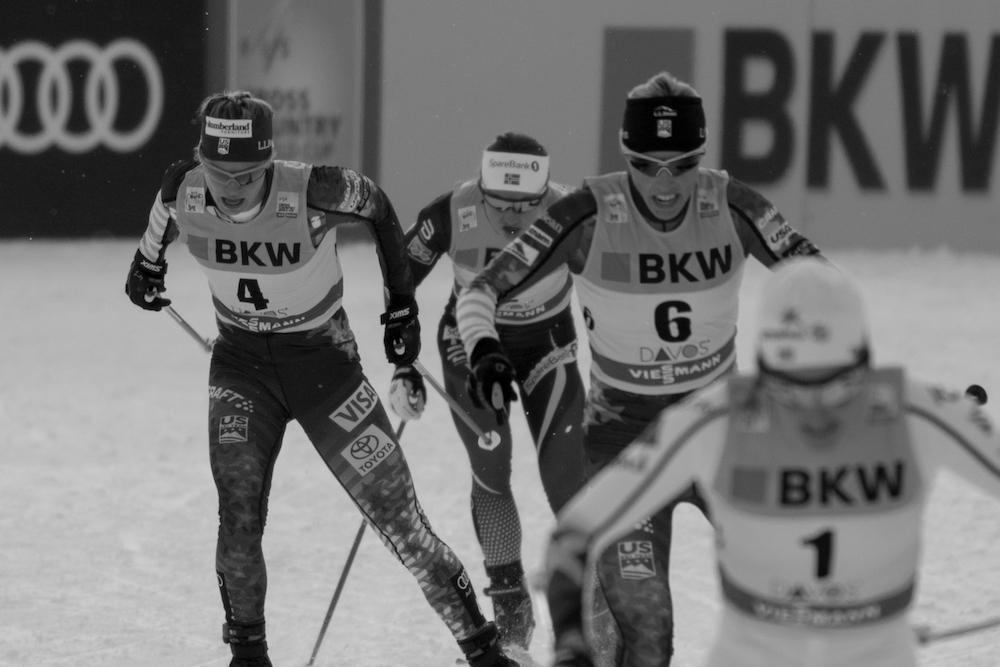
DAVOS, Switzerland — Stina Nilsson came into Saturday’s freestyle sprint looking to return to her winning ways after having a four-sprint victory streak broken last weekend in Lillehammer, Norway.
The Norwegian women came into the day looking to further redeem themselves after a slow – by their standards – start to the season, with Nilsson and her Swedish teammate Charlotte Kalla combining to win four of the five races held so far.
And the U.S. women came in and calmly qualified five women in the top 11 spots, then advanced four of those athletes to the semifinals, three to the final, and one – Kikkan Randall – to the podium.
Jessie Diggins finished fourth, Ida Sargent sixth, Sophie Caldwell eighth, and Sadie Bjornsen 13th.
“We obviously have so much experience in this group right now,” U.S. Ski Team Head Coach Chris Grover said after. “And we probably had the best skis out there today, which is gratifying. A lot of things just kind of came together… I’d say at the same time we’ve been waiting for the first skate sprint of the year. Especially after five races in Scandinavia, with a lot of classic races, to come down and have a first skate weekend was something that the athletes were really looking forward to. So I expect that they’ll have some more good results in tomorrow’s race and in Toblach [Italy] in a week.”
Randall and Diggins 3-4 as Nilsson Wins Again
In the final, none of the Americans – or anyone else – could match a turn of pace produced by Nilsson and Norway’s Maiken Caspersen Falla, who won last weekend’s classic sprint in Lillhammer. The two women skated away halfway through the course, accelerating through the stadium in a race to be first to the turn up to the course’s steep climb.
From there, Nilsson pulled away from Falla. But as she descended back into the stadium, she bobbled coming out of a sharp downhill corner. Falla had a chance, and drew even with the Swede in the finishing lanes.
“I knew the last turn was bad, and I ended up where I shouldn’t have,” Nilsson told NRK, according to a translation. “I knew Maiken came up behind me fast, but I never gave up.”
In a photo finish, Nilsson managed to just hang onto the win by 0.08 seconds.
“It was very close, but I’m very happy,” Falla told NRK. “I put absolutely everything I could into it and went for the win… but there was no more to pick up. But I was pleased.”
Behind the dueling Scandinavians came Randall. Lapping through the stadium halfway through the final, she closely followed Nilsson and Falla. But when they upped the pace, she couldn’t quite respond.
“I was in a perfect place,” she said in a finish-line interview. “I was right behind both of them. I felt the gears shift – the same thing happened in the semifinal. I felt like I did a better job responding to it in the final. And I think there’s a little bit of just sharpening and confidence that will help me bridge that.”

Rather than being discouraged, Randall – who crossed the line 2.53 seconds after Nilsson, well clear of fourth-place Diggins – took it as evidence of exactly what she needs to work on to win.
“It’s cool to just have that concrete example, like, OK, that’s the best, and you’re right here, now you have to work on bridging that before we get to [the Olympics in] Korea,” Randall said.
Randall, a three-time Sprint World Cup champion from 2012 to 2014, hadn’t qualified for quarterfinals in either of the sprints so far this season, both of which were classic races.
“The first couple weekends of the World Cup have been a mixed bag for me,” she said. “I felt like this kind of shape was there, but in classic I haven’t been able to quite put it together. So it’s really nice to know that I have last year all under my belt, a good year of training, and now I’m in a position where I know my fitness is good and I’m just sharpening that race gear as we go. It was really good to lay down a strong effort today.”
Her teammate Diggins couldn’t hang onto her tails, but still finished fourth – 4.41 seconds behind Nilsson, and more than a second ahead of Norway’s Ingvild Flugstad Østberg in fifth.
Given that Diggins had been sick earlier in the week, it was a result she seemed more than happy with.
“I’m so pysched to be able to race this weekend,” Diggins said. “Three days ago I was laying in bed and sick. I was just like, I am just going to go and give it my best. And damn, the podium was right there! And I tried, but I just didn’t get around soon enough. It was so fun to get to another [sprint] final. I am glad to see that sickness didn’t take all of my racing edge.”
Diggins had led the Americans in the qualifier in fourth place. But that didn’t give her complete confidence that the heats would go well, or that she had recovered from her illness and missed training.

“We had really fast skis, so that can make a big difference,” she said of the qualifying round. “And also sometimes your fitness throughout the rounds is different than your two-minute, 45-second sprinting [in the qualifier], so I wanted to see what is going to happen though the day. I was trying to play the patient game.”
Both Diggins and Randall were very much in the mix in the final, and had their heads up for opportunities late in the heat, even after Nilsson and Falla had pulled away. The American skis were running fast on the downhill, and both women knew that if they could shortcut the final corner coming into the finishing chute, they might regain some ground.
“The way our skis were running, the way that corner was skiing, I wasn’t giving any inch,” Randall said. “Anything was possible.”
But both Nilsson and Falla stayed on their feet, and all Randall could do was ski aggressively to third. Likewise, Diggins was pleased with the downhill and corner but there was nobody for her to pass in the final round.
“On that corner, the sketchier it got, the more I liked it,” Diggins said. “My skis were flying on the downhill, and that is a strength of mine for sure. I didn’t quite have [the podium] before that corner so I needed to get a good draft there, and I didn’t quite punch it where I needed to but that’s sprint racing, man.”
Breakthrough for Sargent
Sargent, the third U.S. woman in the final, ran out of gas and finished sixth, 14.49 seconds behind Nilsson. It was the second skate final of her career, her first coming in 2013 in Sochi, Russia. After qualifying in fifth, just 0.41 seconds behind Diggins, she had finished third in a photo finish with Russia’s Natalia Matveeva in her quarterfinal heat.

That was something of a “heat of death”, with Falla, Østberg, Sargent, Matveeva, and third-place qualifier Nadine Fähndrich of Switzerland all vying to advance. Because of that, it was also a fast heat and Sargent was easily the top “lucky loser” from the quarterfinals.
In her semifinal, Sargent took the lead on the first big hill and led the heat before ultimately crossing the line second, 0.42 seconds behind Diggins.
“I was feeling really good and I had great energy today, and I kind of wanted to be up front,” Sargent said. “In the quarterfinal I thought it was harder to stop and go all the time, and it just felt pretty relaxed [in the semifinal]. I tried to stay conservative so I could go for it on the hill in the semi-final… I knew I had to be in the top two.”
By the final, though, Sargent was tiring.
“I think being in the second semifinal — I have never really loved altitude,” she said, referring to the Davos venue’s elevation more than 5,000 feet above sea level. “So I started out and the first lap was OK, and then as we started the second lap, it was just like, oh God, I hit a wall. I felt like I was just struggling to the line, but I am psyched to be in the final. It’s a big step for me.”
In the 2013 sprint final in Sochi, Norway hadn’t brought its A-team. Saturday in Davos was different. As usual in the first period of World Cup racing, the best of the best race every weekend. (Both Kalla and Norway’s Marit Bjørgen sat this race out, but neither has made the top 10 of a sprint so far this season.)
Grover noted that Sargent’s performance followed up on good results in the first weekend of the World Cup, where she finished 15th in the classic sprint and 22nd in the 10 k classic in Kuusamo, Finland.
“We knew she was in good anaerobic and aerobic fitness,” Grover said. “She had a rough weekend last weekend. She was too slick [with wax] in the classic sprint, and she had some problems with breathing in skiathlon. But the previous weekend, we’d seen her anaerobic side on the sprint side was quite good, and her aerobic side with the classic 10 k was quite high. So she’s made a real physiological step forward.”
The physiology isn’t the only thing, though; without tactics and race smarts, simply being in better shape isn’t enough to succeed in World Cup sprinting.
“I think she’s also made a tactical step forward and improved her confidence, and she’s making better moves out there,” Grover said. “Tactics and aerobic fitness always go hand in hand. If you have more aerobic fitness, you can do more things out there. So, I think what we’re seeing there isimproved fitness, making better decisions, and she’s going to have some great results this year.”
Randall, too, was impressed with her teammate.
“I’m just so proud of Ida,” Randall said, “because last week she struggled. But she just reset. She came in this week with a good plan, she laid down a wicked-fast qualifier, and to ski that gutsy race in the semifinal, leading from the front – just so cool to see. She has always been right there, but she has obviously just upped it a level. So that’s really cool. We’re getting closer to an all-American final. Someday.”
Caldwell, Bjornsen in the Heats
Caldwell advanced to the semifinals, but was unable to find her place in the pack and finished fourth in the heat where Diggins and Sargent went 1-2.
“I started from the back, which is fine, but then I just couldn’t really move to the front,” Caldwell said. “But so it goes. Honestly, I felt pretty terrible today, and I just kept telling myself maybe everyone does? I wanted to conserve energy when I could.”
Bjornsen, meanwhile, was out after the quarterfinals, missing “lucky loser” status by just one place. After two classic sprint podiums to start off the season, she ended up 13th.
“I was going to try to stay behind [Nilsson], but then she kind of went slow at the beginning,” Bjornsen said of the heat. “When she made her move I was kind of stuck behind everyone unfortunately. I was able to make a nice move over the top of the hill, but I think I just took that last corner wrong. I should have gone on the inside of [Finland’s] Krista [Pärmäkoski] and I didn’t.”
Bjornsen said she had made a tactical mistake, but that her fitness and feeling was every bit as good as in those podium-worthy classic sprints.
“Sometimes I think that hardest thing is making it through the quarterfinals,” she said. “Once I get beyond that I find my groove better. Today it wasn’t perfect, but I think I am in the same place in skating [as in classic] so we will have more chances this year.”
Also for the U.S., Julia Kern finished 57th in qualifying, 16.55 seconds off the pace set by Nilsson and 6.42 seconds out of the top 30.
Canada’s Dahria Beatty finished 53rd in qualifying (+15.53 seconds), Katherine Stewart-Jones followed in 55th (+16.18), and Cendrine Browne was 64th (+18.27).
Results: Women’s final | Women’s qualifier
— Ian Tovell and Andrea Potyodny-Smith contributed

Chelsea Little
Chelsea Little is FasterSkier's Editor-At-Large. A former racer at Ford Sayre, Dartmouth College and the Craftsbury Green Racing Project, she is a PhD candidate in aquatic ecology in the @Altermatt_lab at Eawag, the Swiss Federal Institute of Aquatic Science and Technology in Zurich, Switzerland. You can follow her on twitter @ChelskiLittle.



